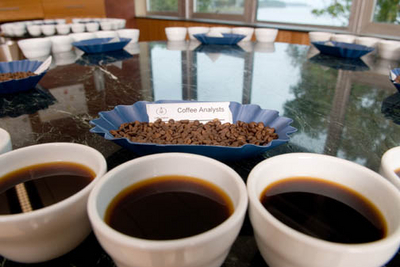Testing for Coffee Shelf Life
Packaging and the maintenance of packaging equipment is one of the biggest challenges in the roasting facility. Coffee Analysts has designed shelf–life tests so that several samples from a batch are tested at once. Especially in the case of coffee packaging, only testing one bag will not give adequate information about the packaging system.
Use of the leak detector: When excessive oxygen is found, it is important to determine the source. If the equipment is not sealing the bag properly, pinhole leaks can develop that allow small amounts of oxygen into the package over time (immediately after manufacture, no oxygen will be detected). By isolating the location of these leaks, the equipment can be adjusted as necessary.
Often, no leaks are detected in a package with excessive oxygen. This can be a sign that the bags are not being fully flushed with nitrogen, possibly as the result of the packaging line moving too fast.
Valve Bags
For packages with valves, testing for both carbon dioxide and oxygen is recommended. If the coffee was packaged soon after roasting the carbon dioxide level can be as high as 80% after a week. If no carbon dioxide is found in a plastic-covered pinhole valve, the shelf life of the product may be limited.
Fractionally Packaged Coffee
For serving size roasted ground coffee, it is suggested that a random case of product be sent for analysis. All bags are quickly checked for leaks and 20% of the total are tested for oxygen and leaks.
Other Shelf Life Issues
Where oxygen is the main fuel for staling, excessive moisture absorption accelerates the staling process. For this reason, water activity (the ratio of free water to bound water) is also measured. Work done at the University of Minnesota by Dr. Ted Labuza show that when the water activity is raised to 0.35, the rate of staling increases dramatically. A more ideal level for a medium–roast coffee is 0.20–0.22. Excessive water activity indicates that the coffee was in contact with humid conditions for an extended period of time before packaging or that the package material is an inadequate moisture barrier.


